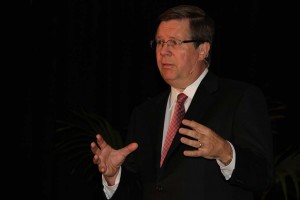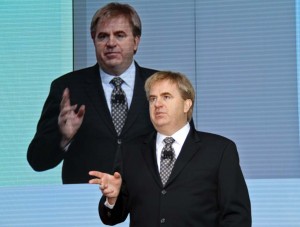
Toyota's Jim Lentz believes the key to U.S. auto sales rebounding in 2017 is held by Donald Trump and his infrastructure plan.
April’s weak sales numbers have flagged growing concerns that the U.S. auto market is finally set to slide after seven consecutive years of growth.
But at least one senior industry official is betting that the market could rebound if and when President Donald Trump can implement the big infrastructure program he has been calling for.
“If you get a $1 trillion stimulus, that could add 800,000 units,” Jim Lentz, CEO of Toyota North America, said during a preview of the maker’s expanded technical center near Ann Arbor, Michigan, on Thursday morning.
While slow sales since January have started to worry many industry observers, manufacturers have not yet made the sort of production cuts that a significant downturn might require. And anticipation for the infrastructure stimulus package, said Lentz, is “one reason everyone is on the accelerator.”
Auto sales dipped 4.7% in the U.S. in April, a sharper decline than had been forecast, and the fourth consecutive down month. Most observers now expect 2017 to bring to an end the long new vehicle boom that followed the worst industry meltdown since the Great Recession.
But how far down things will go is uncertain. IHS Automotive, for one, is predicting the numbers will dip to 17.4 million for all of 2017, off just about 100,000 units from last year – 2016 marking the third consecutive annual industry record. That said, analyst Stephanie Brinley said more declines like April could lead the consulting firm to rejigger its numbers, and others, such as LMC Automotive, have already reduced their 2017 forecasts.
(New vehicle sales tumble in April. Find out why, Click Here.)
Without a boost, whether from the White House or elsewhere, automakers may have to soon decide, “when is it prudent to lift off the accelerator,” Lentz cautioned.
It’s not just the overall sales figures that are worrisome, said David Andrea, an industry veteran with the Center for Automotive Research, in Ann Arbor. It’s “all the other symptoms of a (new car) cycle getting long in the legs.”
Automakers are straining to keep demand propped up. They’re writing more leases, as well as extended loans. Fully one-third of retail sales during the first quarter were backed by loans of at least 72 months, according to industry data. And a big push into sub-prime and extreme sub-prime loans has resulted in the highest levels of delinquencies since 2008, just before the industry’s worst crash since the Great Depression, reported the Federal Reserve Bank of New York.
Other disturbing signs include the steady rise in rebates and other incentives, warned Bob Carter, head of U.S. automotive operations for Toyota. The Japanese giant’s givebacks are “higher than we’ve ever experienced,” he said during an industry forum marking the opening of the New York International Auto Show last month. Industry-wide, automakers report incentives are averaging about $3,900 a vehicle, or roughly 10% of the typical sticker price.
(Trump open to hiking gas tax. To find out why, Click Here.)
Even so, prices have been on a fast rise in recent years – partly driven by consumers trading up and then loading vehicles up with options – something that has narrowed the segment of consumers who can even consider a new vehicle anymore, even with discounts and extended loans.
There comes a fine line between buoying the market and throwing good money after bad. And with many manufacturers reporting dealer inventories well above the industry norm of around 60 days’ supply, analyst Brinley says the question will come down to whether an individual company wants to retain market share or focus on profitability.
Since the end of the Great Recession, analysts Brinley and Andrea agree, most manufacturers have maintained a good discipline. Industry observers, on the whole, praise companies like Ford and GM for their willingness to order short-term production cuts to keep things in balance. But the real test wlll come, they say, if and when sales start falling off more precipitously.
Even if the market manages to hold relatively steady – and IHS believes the industry could see volumes in the 17 million range for another three years or so – manufacturers are expected to take an increasingly cautious approach.
There have been some big investments announced in recent months, though most have been aimed at shifting production from slow-selling passenger cars to hotter SUVs and pickups.
It’s another matter entirely to ask manufacturers to start building plants in a slowing U.S. market to replace factories in Mexico, China or other parts of the world, said CAR’s Andrea, as Pres. Trump has been demanding.
(To find out why Maryland is the safest state for teen drivers, Click Here.)
“You’re not going to bring back jobs and add capacity going into a downturn,” he said, adding that investors are “watching closely” to make sure carmakers maximize returns on investment, rather than build new factories in the name of politics.


For a long time now, since the late 1960’s the autosales is one of the leading indicators for the economy. But most articles I read are always being compared to the last recession, boom or bust period this county has gone through. But I doubt these numbers could ever be achieved since there is not the middle class working base as there was. In the last year I purchased a “Dewalt” electric drill. A USA name and company but where was it made? China. When was the last time did you see “Made in America” on any household appliance, vacuum cleaners, toasters and alike? I agree that China and other countries has given us low cost products so we can still buy a toaster for $10 but until we get a few million people making these kind of household products in the USA, it will be hard pressed to sustain numbers industry leaders and investors want to rely on.
George, to your point, only about 5% of Americans now typically buy a new car each year.
Paul E.